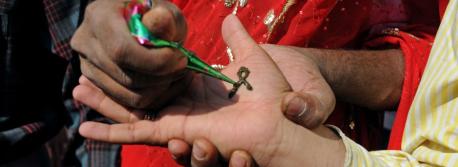
AIDS-Free Generation
An AIDS-free generation is within reach
The necessary tools and know-how for winning the fight against HIV/AIDS exist. Achieving an AIDS-free generation is a matter of reaching every child and every adolescent who is at risk. UNICEF's strategy includes:
- protecting the health of pregnant and breastfeeding women living with HIV
- making sure that children have access to antiretroviral therapy (ART)
- focusing on prevention and treatment during adolescence, so that children remain AIDS-free in the second decade of life
- ensuring social protection and child protection, care and support through the first two decades of life
Breaking the Cycle
This disease affects non–infected children as well—many are left orphaned or grow up in communities overwhelmed by the disease. UNICEF employs a multifaceted approach that includes:
- high-impact HIV prevention, treatment and care for adolescents
- prevention of mother-to-child transmission
- increasing empowerment and reducing vulnerability through programs for HIV-affected adolescents
- addressing gender-based violence and gender inequalities
- equitable quality education including comprehensive HIV knowledge
- human rights advocacy and the promotion of enabling laws and policies
- prioritizing at-risk adolescents who are at higher risk of HIV exposure
"The HIV epidemic enters its fifth decade amid a global pandemic that has overloaded health care systems and constrained access to life-saving services; meanwhile, rising poverty, mental health issues, and abuse are increasing children and women’s risk of infection,” UNICEF Executive Director Henrietta Fore said on the eve of World AIDS Day 2021.
“Unless we ramp up efforts to resolve the inequalities driving the HIV epidemic — which are now exacerbated by COVID-19 — we may see more children infected with HIV and more children losing their fight against AIDS.”
Top photo: A health worker draws the ribbon symbol for HIV awareness in traditional mendhi dye. UNICEF/INDA2010-00043/CANDACE FEIT